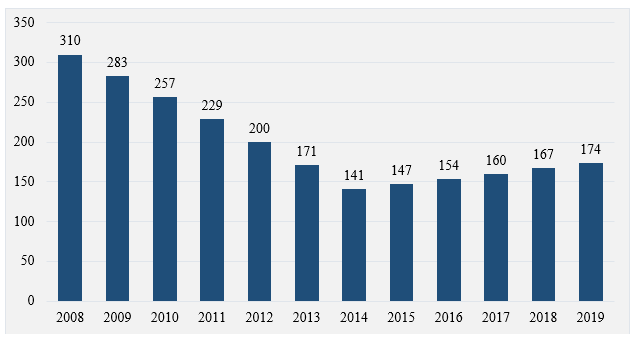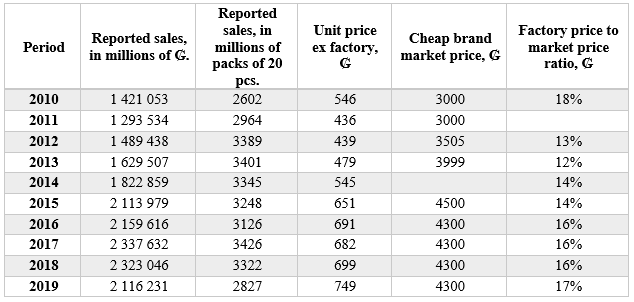
By Rodrigo Ibarrola
A little over a year ago, the Center for Analysis and Dissemination of the Paraguayan Economy (CADEP), the best think tank in the country, 17th in the region and 68th in the world (in international economic policy), highlighted the excess production of cigarettes by the national tobacco complex. The study provoked heated controversies on the management of the industry and energetic replies from the business association and its associated press media.
The CADEP study used internationally validated methodologies to estimate local production and use (with assistance from the University of Illinois, Chicago). Strictly speaking, the report only reconfirmed what other reports had already found in tobacco production: an excess of production that is not in line with national consumption, which sparks suspicions about the destination of the bulk of local production.
To estimate tobacco production, CADEP used the available information on raw materials used in the production process: in method 1, the import of cellulose filaments for filter production (Central Bank of Paraguay, BCP), a technique applied in a previous study in 2018, and, in method 2, the local production and import of unprocessed tobacco (data from the Ministry of Agriculture and Livestock and the BCP), a technique also carried out in 2018, by another study. The results of these calculations -always estimates- were quite close to the production admitted by the representative of the Paraguayan Tobacco Union (UTP), José Ortiz Escauriza.
Graph 1. Estimated production (method 1 and 2), industry output. In millions of 20-cigarette packs

Source: Own creation based on CADEP and UTP data.
To determine the demand for cigarettes, i.e., local use, CADEP integrated data from various surveys, such as the Integrated Household Survey (EIH) of 1997/1998 and 2000/2001 and the Survey of Income and Expenditures and Living Conditions (EIGyCV) 2011-2012, of the former General Directorate of Statistics, Surveys and Censuses (DGEEC). In addition, information was taken from the Global Youth Tobacco Use Survey (EGTJ) for the years 2003, 2008, 2014 and 2019, a component of the Global Tobacco Surveillance System, supported by the Ministry of Education and Science (MEC), the Ministry of Public Health and Social Welfare (MSPBS) and the Pan American Health Organization (PAHO). The 2011 National Survey of Risk Factors for Noncommunicable Diseases (ENFR), prepared by the MSPBS, was also considered, according to which the prevalence of individual consumption was 14.6% of the population over 15 years of age. The estimate of total domestic use is shown in the following graph.
Graph 2. Estimated domestic consumption. In millions of 20-cigarette packs

Source: Own creation with CADEP data.
The controversy regarding the CADEP study arose from the estimated production declared to the Undersecretariat of State for Taxation (SET), which was calculated based on the average sales price in the market, resulting in a sales volume lower than the estimated production. In other words, it was considered as an indication of the existence of tax evasion by the tobacco complex. Since the tax returns are made based on the factory sales price -always lower than the sales price to the final consumer-, the declared sales estimate was underestimated. Consequently, this error caused the tobacco growers to file a civil lawsuit against CADEP, which subsequently retracted this point and published a new version of the document omitting this chapter. Apart from the situation mentioned above, the other data presented are still absolutely valid.
The issue is that it is impossible to determine -with certainty- the factory sales prices without an on-site verification of the documentation. Factory sales prices are reported to SET only through a monthly affidavit. In addition, the SET’s Hechauka system, which captures the invoices issued by the companies, does not record the declared sales concepts of the invoicing.
Despite this, we have tested a method to determine the average factory price, based on the annual aggregate production data contained in Form 160, obtained from SET through the Public Information portal. Based on this, the factory selling price has been determined to be ₲749 per pack for 2019 (Table 1). Clarifying that this value is -just- an average of aggregated data, certainly, not exact, but quite approximate.
Table 1. Reported sales, ex-factory price and market price

Source: Own with data from SET, UTP, The Economist Intelligence Unit.
On the other hand, reviewing data from the Sofia System of the National Customs Directorate (DNA), it has been determined that the amount of cigarette packs exported by the tobacco complex has decreased by 59% since 2012, standing at around 152 million packs (Graph 3). A noteworthy fact is that, in DNA’s records, no exports to Brazil are recorded within the period shown. However, it is the most common site for cigarette seizures, in addition to seizures in Argentina, Uruguay, Chile, Peru and Colombia.
Graph 3. Estimated domestic use. In millions of 20-cigarette packs

Source: Own creation with DNA data.
From the production and export data obtained, and under the assumption that domestic consumption is given by estimated demand, it can be concluded that there is a gap of about 2501 million packs in excess. That is, the difference between estimated production minus what is used locally (according to smoking prevalence) and what is exported, left that number (2501 million packs) whose destination or use, in real terms, is unknown.
Figure 4. Existing gap between production and domestic use plus exports. In millions of packs of 20 cigarettes.

Source: Own creation with data from SET, UTP and DNA.
The CADEP study used internationally validated methodologies to estimate local production and use (with assistance from the University of Illinois, Chicago). Strictly speaking, the report only reconfirmed what other reports had already found in tobacco production: an excess of production that is not in line with national consumption, which sparks suspicions about the destination of the bulk of local production.
Assuming the prevalence of consumption of 14.6%, we would have a total of 738,889 smokers over 15 years of age in 2019, who should have smoked, on average, 9 packs per day each that year. An absurdity.
Therefore, it is worth asking -as did the former Minister of the Interior, Arnaldo Giuzzio- “Mava piko la opitaitereía ñande retame? (Translation from the native Guarani language: Who in our country is smoking so much?”
Cover image: ABC Color.
